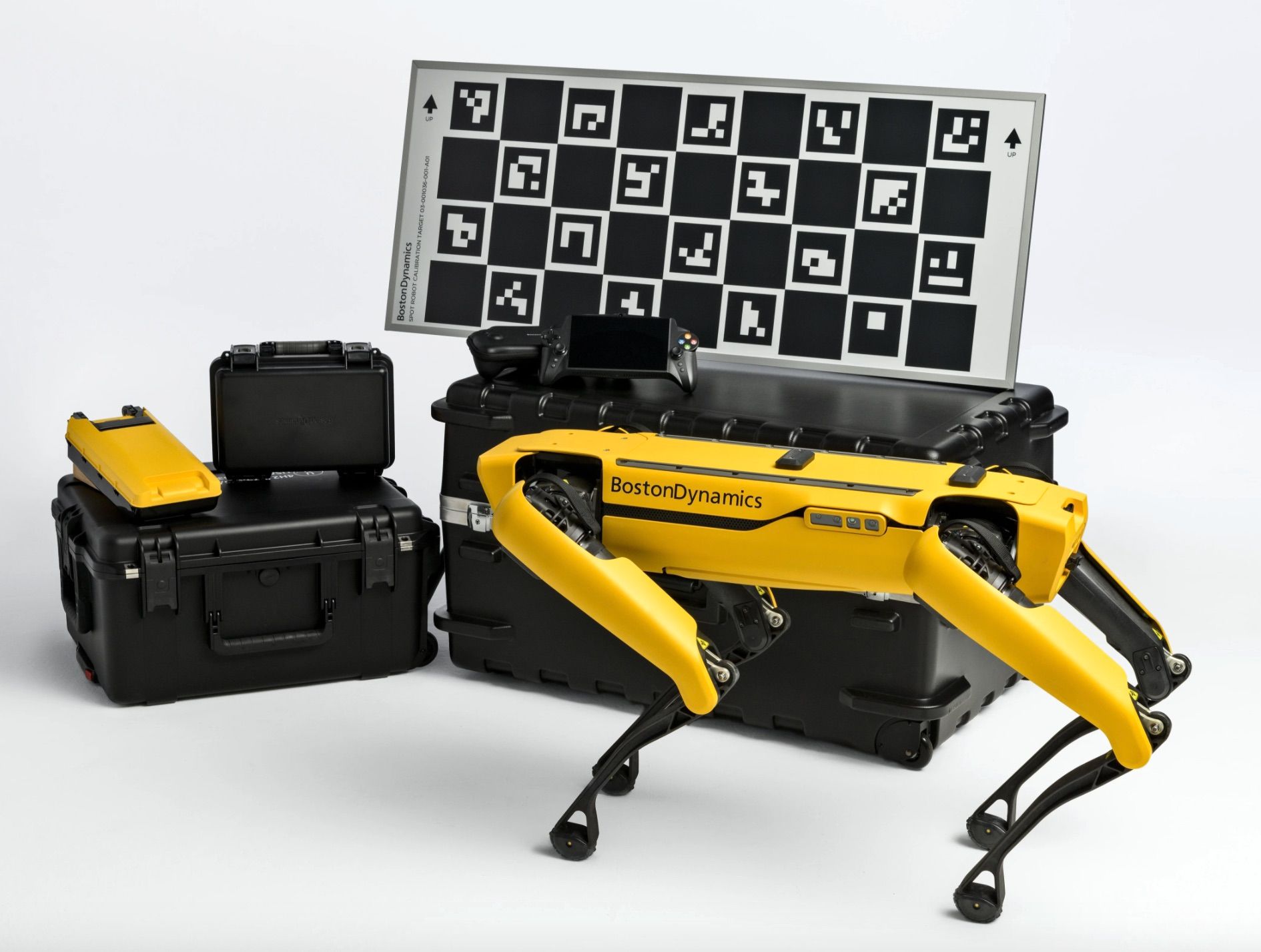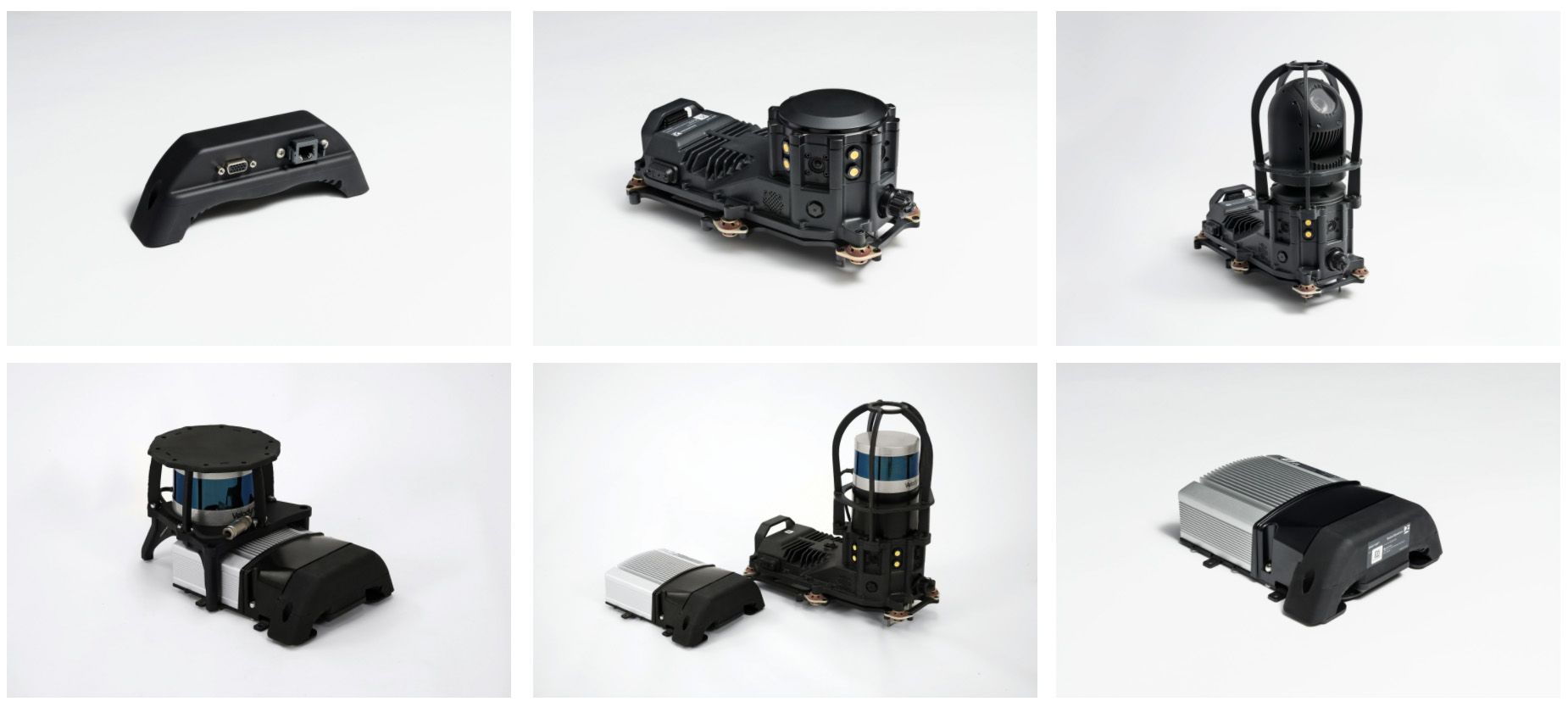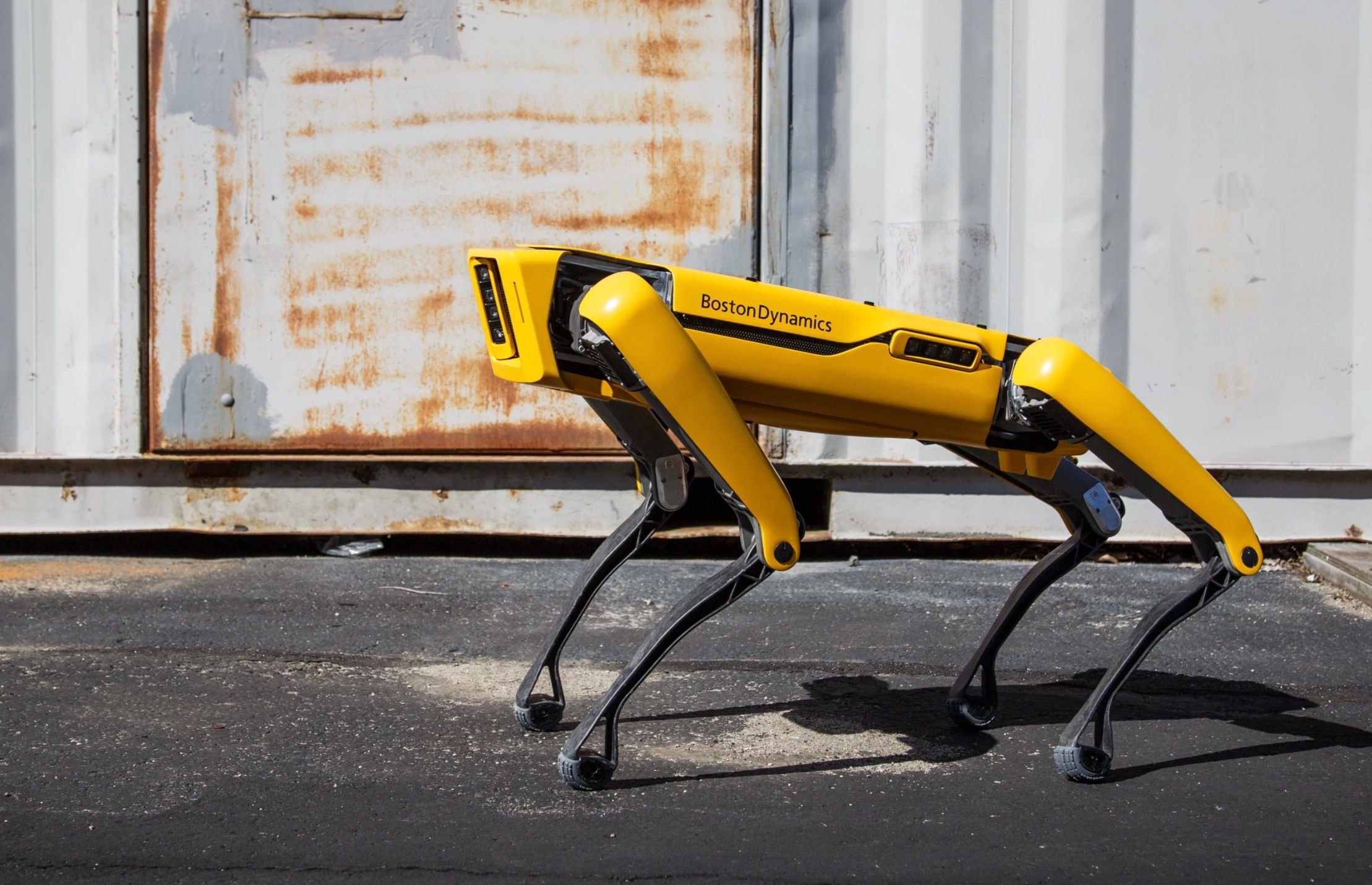Boston Dynamics' Spot Robot Dog Now Available for $74,500
Boston Dynamics has been fielding questions about when its robots are going to go on sale and how much they'll cost for at least a dozen years now. I can say this with confidence, because that's how long I've been a robotics journalist, and I've been pestering them about it the entire time. But it's only relatively recently that the company started to make a concerted push away from developing robots exclusively for the likes of DARPA into platforms with more commercial potential, starting with a compact legged robot called Spot, first introduced in 2016.
Since then, we've been following closely as Spot has gone from a research platform to a product, and today, Boston Dynamics is announcing the final step in that process: commercial availability. You can now order a Spot Explorer Kit from the Boston Dynamics online store for US $74,500 (plus tax), shipping included, with delivery in 6 to 8 weeks. FINALLY!
Over the past 10 months or so, Boston Dynamics has leased Spot robots to carefully selected companies, research groups, and even a few individuals as part of their early adopter program-that's where all of the clips in the video below came from. While there are over 100 Spots out in the world right now, getting one of them has required convincing Boston Dynamics up front that you knew more or less exactly what you wanted to do and how you wanted to do it. If you're a big construction company or the Jet Propulsion Laboratory or Adam Savage, that's all well and good, but for other folks who think that a Spot could be useful for them somehow and want to give it a shot, this new availability provides a fewer-strings attached opportunity to do some experimentation with the robot.
There's a lot of cool stuff going on in that video, but we were told that the one thing that really stood out to the folks at Boston Dynamics was a 2-second clip that you can see on the left-hand side of the screen from 0:19 to 0:21. In it, Spot is somehow managing to walk across a spider web of rebar without getting tripped up, at faster than human speed. This isn't something that Spot was specifically programmed to do, and in fact the Spot User Guide specifically identifies rebar mesh" as an unsafe operating environment. But the robot just handles it, and that's a big part of what makes Spot so useful-its ability to deal with (almost) whatever you can throw at it.
Before you get too excited, Boston Dynamics is fairly explicit that the current license for the robot is intended for commercial use, and the company specifically doesn't want people to be just using it at home for fun. We know this because we asked (of course we asked), and they told us we specifically don't want people to just be using it at home for fun." Drat. You can still buy one as an individual, but you have to promise that you'll follow the terms of use and user guidelines, and it sounds like using a robot in your house might be the second-fastest way to invalidate your warranty:
SPOT IS AN AMAZING ROBOT, BUT IS NOT CERTIFIED SAFE FOR IN-HOME USE OR INTENDED FOR USE NEAR CHILDREN OR OTHERS WHO MAY NOT APPRECIATE THE HAZARDS ASSOCIATED WITH ITS OPERATION.
Not being able to get Spot to play with your kids may be disappointing, but for those of you with the sort of kids who are also students, the good news is that Boston Dynamics has carved out a niche for academic institutions, which can buy Spot at a discounted price. And if you want to buy a whole pack of Spots, there's a bulk discount for Enterprise users as well.
What do you get for $74,500? All this!
- Spot robot
- Spot battery (2x)
- Spot charger
- Tablet controller and charger
- Robot case for storage and transportation
- FREE SHIPPING!
 Photo: Boston Dynamics The basic package includes the robot, two batteries, charger, a tablet controller, and a storage case.
Photo: Boston Dynamics The basic package includes the robot, two batteries, charger, a tablet controller, and a storage case. You can view detailed specs here.
So is $75k a lot of money for a robot like Spot, or not all that much? We don't have many useful points of comparison, partially because it's not clear to what extent other pre-commercial quadrupedal robots (like ANYmal or Aliengo) share capabilities and features with Spot. For more perspective on Spot's price tag, we spoke to Michael Perry, vice president of business development at Boston Dynamics.
IEEE Spectrum: Why is Spot so affordable?
Michael Perry: The main goal of selling the robot at this stage is to try to get it into the hands of as many application developers as possible, so that we can learn from the community what the biggest driver of value is for Spot. As a platform, unlocking the value of an ecosystem is our core focus right now.
Spectrum: Why is Spot so expensive?
Perry: Expensive is relative, but compared to the initial prototypes of Spot, we've been able to drop down the cost pretty significantly. One key thing has been designing it for robustness-we've put hundreds and hundreds of hours on the robot to make sure that it's able to be successful when it falls, or when it has an electrostatic discharge. We've made sure that it's able to perceive a wide variety of environments that are difficult for traditional vision-based sensors to handle. A lot of that engineering is baked into the core product so that you don't have to worry about the mobility or robotic side of the equation, you can just focus on application development.
 Photos: Boston Dynamics Accessories for Spot include [clockwise from top left]: Spot GXP with additional ports for payload integration; Spot CAM with panorama camera and advanced comms; Spot CAM+ with pan-tilt-zoom camera for inspections; Spot EAP with lidar to enhance autonomy on large sites; Spot EAP+ with Spot CAM camera plus lidar; and Spot CORE for additional processing power.
Photos: Boston Dynamics Accessories for Spot include [clockwise from top left]: Spot GXP with additional ports for payload integration; Spot CAM with panorama camera and advanced comms; Spot CAM+ with pan-tilt-zoom camera for inspections; Spot EAP with lidar to enhance autonomy on large sites; Spot EAP+ with Spot CAM camera plus lidar; and Spot CORE for additional processing power. The $75k that you'll pay for the Spot Explorer Kit, it's important to note, is just the base price for the robot. As with other things that fall into this price range (like a luxury car), there are all kinds of fun ways to drive that cost up with accessories, although for Spot, some of those accessories will be necessary for many (if not most) applications. For example, a couple of expansion ports to make it easier to install your own payloads on Spot will run you $1,275. An additional battery is $4,620. And if you want to really get some work done, the Enhanced Autonomy Package (with 360 cameras, lights, better comms, and a Velodyne VLP-16) will set you back an additional $34,570. If you were hoping for an arm, you'll have to wait until the end of the year.
Each Spot also includes a year's worth of software updates and a warranty, although the standard warranty just covers defects related to materials and workmanship" not I drove my robot off a cliff" or I tried to take my robot swimming." For that sort of thing (user error) to be covered, you'll need to upgrade to the $12,000 Spot CARE premium service plan to cover your robot for a year as long as you don't subject it to willful abuse, which both of those examples I just gave probably qualify as.
While we're on the subject of robot abuse, Boston Dynamics has very sensibly devoted a substantial amount of the Spot User Guide to help new users understand how they should not be using their robot, in order to lessen the risk of serious injury, death, or robot and other property damage." According to the guide, some things that could can Spot to fall include holes, cliffs, slippery surfaces (like ice and wet grass), and cords. Spot's sensors also get confused by transparent, mirrored, or very bright obstacles," and the guide specifically says Spot may crash into glass doors and windows." Also this: Spot cannot predict trajectories of moving objects. Do not operate Spot around moving objects such as vehicles, children, or pets."
We should emphasize that this is all totally reasonable, and while there are certainly a lot of things to be aware of, it's frankly astonishing that these are the only things that Boston Dynamics explicitly warns users against. Obviously, not every potentially unsafe situation or thing is described above, but the point is that Boston Dynamics is willing to say to new users, here's your robot, go do stuff with it" without feeling the need to hold their hand the entire time.
There's one more thing to be aware of before you decide to buy a Spot, which is the following:
All orders will be subject to Boston Dynamics' Terms and Conditions of Sale which require the beneficial use of its robots."
Specifically, this appears to mean that you aren't allowed to (or supposed to) use the robot in a way that could hurt living things, or as a weapon, or to enable any weapon." The conditions of sale also prohibit using the robot for any illegal or ultra-hazardous purpose," and there's some stuff in there about it not being cool to use Spot for nuclear, chemical, or biological weapons proliferation, or development of missile technology," which seems weirdly specific.
Once you make a technology more broadly available, the story of it starts slipping out of your hands. Our hope is that ahead of time we're able to clearly articulate the beneficial uses of the robot in environments where we think the robot has a high potential to reduce the risk to people, rather than potentially causing harm." -Michael Perry, Boston DynamicsI'm very glad that Boston Dynamics is being so upfront about requiring that Spot is used beneficially. However, it does put the company in a somewhat challenging position now that these robots are being sold. Boston Dynamics can (and will) perform some amount of due-diligence before shipping a Spot, but ultimately, once the robots are in someone else's hands, there's only so much that BD can do.
Spectrum: Why is beneficial use important to Boston Dynamics?
Perry: One of the key things that we've highlighted many times in our license and terms of use is that we don't want to see the robot being used in any way that inflicts physical harm on people or animals. There are philosophical reasons for that-I think all of us don't want to see our technology used in a way that would hurt people. But also from a business perspective, robots are really terrible at conveying intention. In order for the robot to be helpful long-term, it has to be trusted as a piece of technology. So rather than looking at a robot and wondering, is this something that could potentially hurt me," we want people to think this is a robot that's here to help me." To the extent that people associate Boston Dynamics with cutting edge robots, we think that this is an important stance for the rollout of our first commercial product. If we find out that somebody's violated our terms of use, their warranty is invalidated, we won't repair their product, and we have a licensing timeout that would prevent them from accessing their robot after that timeout has expired. It's a remediation path, but we do think that it's important to at least provide that as something that helps enforce our position on use of our technology.
It's very important to keep all of this in context: Spot is a tool. It's got some autonomy and the appearance of agency, but it's still just doing what people tell it to do, even if those things might be unsafe. If you read through the user guide, it's clear how much of an effort Boston Dynamics is making to try to convey the importance of safety to Spot users-and ultimately, barring some unforeseen and catastrophic software or hardware issues, safety is about the users, rather than Boston Dynamics or Spot itself. I bring this up because as we start seeing more and more Spots doing things without Boston Dynamics watching over them quite so closely, accidents are likely inevitable. Spot might step on someone's foot. It might knock someone over. If Spot was perfectly safe, it wouldn't be useful, and we have to acknowledge that its impressive capabilities come with some risks, too.
 Photo: Boston Dynamics Each Spot includes a year's worth of software updates and a warranty, although the standard warranty just covers defects related to materials and workmanship" not I drove my robot off a cliff."
Photo: Boston Dynamics Each Spot includes a year's worth of software updates and a warranty, although the standard warranty just covers defects related to materials and workmanship" not I drove my robot off a cliff." Now that Spot is on the market for real, we're excited to see who steps up and orders one. Depending on who the potential customer is, Spot could either seem like an impossibly sophisticated piece of technology that they'd never be able to use, or a magical way of solving all of their problems overnight. In reality, it's of course neither of those things. For the former (folks with an idea but without a lot of robotics knowledge or experience), Spot does a lot out of the box, but BD is happy to talk with people and facilitate connections with partners who might be able to integrate specific software and hardware to get Spot to do a unique task. And for the latter (who may also be folks with an idea but without a lot of robotics knowledge or experience), BD's Perry offers a reminder Spot is not Rosie the Robot, and would be equally happy to talk about what the technology is actually capable of doing.
Looking forward a bit, we asked Perry whether Spot's capabilities mean that customers are starting to think beyond using robots to simply replace humans, and are instead looking at them as a way of enabling a completely different way of getting things done.
Spectrum: Do customers interested in Spot tend to think of it as a way of replacing humans at a specific task, or as a system that can do things that humans aren't able to do?
Perry: There are what I imagine as three levels of people understanding the robot applications. Right now, we're at level one, where you take a person out of this dangerous, dull job, and put a robot in. That's the entry point. The second level is, using the robot, can we increase the production of that task? For example, take site documentation on a construction site-right now, people do 360 image capture of a site maybe once a week, and they might do a laser scan of the site once per project. At the second level, the question is, what if you were able to get that data collection every day, or multiple times a day? What kinds of benefits would that add to your process? To continue the construction example, the third level would be, how could we completely redesign this space now that we know that this type of automation is available? To take one example, there are some things that we cannot physically build because it's too unsafe for people to be a part of that process, but if you were to apply robotics to that process, then you could potentially open up a huge envelope of design that has been inaccessible to people.
To order a Spot of your very own, visit shop.bostondynamics.com.